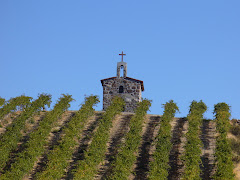Every now and then, I like to review things I’ve learned about wine, seeing as how I am supposed to be studying for several wine certifications. Take for example, Tempranillo, arguably the premier grape of Spain (though Grenache is more widely planted). The thing I find most fascinating about Tempranillo is that it has so many “aliases.” Depending upon the region from which it hails, Tempranillo can be called Ull de Llebre or Ojo de Llebre in Catalonia, Cencibel in La Mancha or Valdepeñas, Tinto Fino in the Ribera del Duero, Tinto Madrid in Arganda, Tinto de la Rioja in the Rioja, Tinto del Toro in the Toro, Grenache de Logrono, Tinto del Pais or Jacivera in other parts of Spain, Aragonez or Tinto Roriz in Portugal, and it may actually be the grape variety Valdepeñas in California.
The main reason Tempranillo has so many pseudonyms is that the grape mutates to adapt to the various microclimates throughout Spain and Portugal, enabling itself to flourish in its environment. The Tempranillo grape in Rioja is usually more Pinot Noir-like, given the much cooler climate in comparison to the hotter climate of the Toro (where it is Tinto del Toro). And the Tinto Roriz of Portugal is much more Zin-like, with spicy, brambly flavors, as opposed to the Tinto Fino of the Ribera, where it usually takes on an almost Cab-like quality, with heavier tannins and more cherry flavors.
The Tempranillo grape is durable, runs the gamut of styles, from soft and fruity to big and bold, and always has a style to fit anyone’s palate. Here are a few examples of just how different they can be:
1. Campos Reales Tempranillo 2005, La Mancha ($7.99). Medium-bodied with red berry fruit, nutmeg, mocha and earth.
2. Maurodos Prima Toro 2005, Toro ($15.99). Rich, lush red with smooth tannins, full-bodied flavors of chocolate, espresso, blackberry and black tea.
3. Vale do Bomfin Douro 2005, Portugal ($12.98). (40% Touriga Franca, 20% Tinta Barroca). Has all the appearances of a Zinfandel from the Lodi, with spicy blue and black fruit flavors, hints of peppercorn, and cinnamon.
4. Vacceos Tempranillo 2005, Rueda ($10.79). (10% Viuda). From the more northern part of Spain, this lively version has cherry, nectarine and even some apricot flavors.
5. Montebaco Crianza 2004, Ribera del Duero ($16.98). Fragrant nose with rose petals and vanilla bean. Loads of chewy raspberry and blackberry fruit with a slight bitter finish.
6. El Puntido Rioja 2003, Rioja ($47.98). Arguably one of Rioja’s best, this big, bold atypical Rioja possesses intense blueberry and cassis aromas and flavors, solid tannic grip and an unceasing finish.
7. Tittarelli Tempranillo Reserva 2004, Mendoza ($9.98 special). Oddly enough, you are seeing more producers in Argentina dabbling in this grape. This particular example shows their Italian influences, taking on the guise of a Vino Nobile di Montepulciano-styled Sangiovese with bright acidity woven throughout a tapestry of cherry fruit, plush tannins and a lingering finish.
Subscribe to:
Post Comments (Atom)











1 comment:
Gorgeous!
Post a Comment